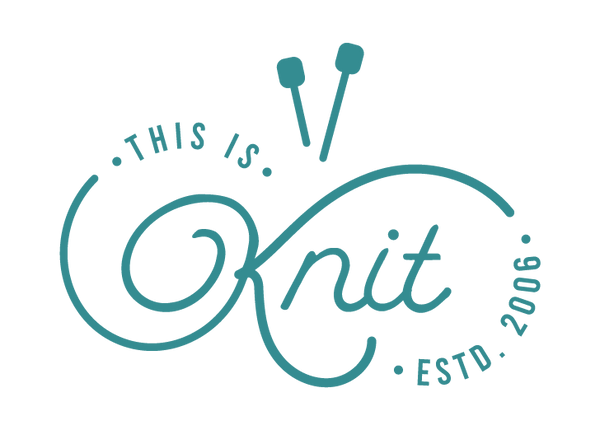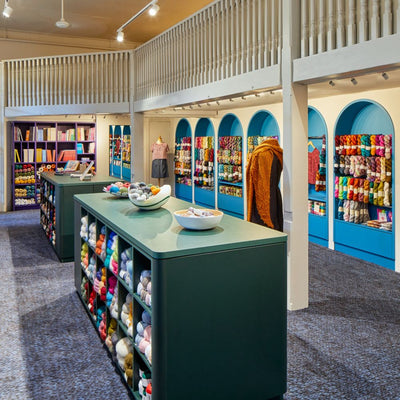At the same time
December 06 2011 – thisisknit
Those four little words induce dread in a lot of knitters. You find them in pattern shaping instructions like this:
 Looking at the instructions above, there's one set of instructions for the beginning of even-numbered rows and another for the beginning of odd-numbered rows. This tells you that the piece will be changing shape at both sides at once. But marking up your sheet of paper, it's easier to concentrate on one of these at a time, so we'll illustrate with the odd numbered rows first.
The first line on the page is Row 1, so it gets the very first bit of shaping. Then you count 6 rows on from there on your paper, and that's where you put the second increase. We've found that you don't need to write down anything more fancy than "Inc 2".
Looking at the instructions above, there's one set of instructions for the beginning of even-numbered rows and another for the beginning of odd-numbered rows. This tells you that the piece will be changing shape at both sides at once. But marking up your sheet of paper, it's easier to concentrate on one of these at a time, so we'll illustrate with the odd numbered rows first.
The first line on the page is Row 1, so it gets the very first bit of shaping. Then you count 6 rows on from there on your paper, and that's where you put the second increase. We've found that you don't need to write down anything more fancy than "Inc 2".
 Carry on like this, putting in each odd row instruction, and your sheet of paper will look like this:
Carry on like this, putting in each odd row instruction, and your sheet of paper will look like this:
 That's the shaping for one side of the piece sorted, so you can move on to the shaping on the other side, which you work at the same time (that's that phrase again!)
That's the shaping for one side of the piece sorted, so you can move on to the shaping on the other side, which you work at the same time (that's that phrase again!)
 When you've added in the even-numbered row shaping, you'll have a sheet of paper which tells you for every row whether you increase or decrease on it. Even though there's two sets of shaping going on, you never have to worry about any row other than the one you're on, and your chart tells you whether you need to do anything on it or not. Having only one row to think about makes the whole thing much easier.
When you've added in the even-numbered row shaping, you'll have a sheet of paper which tells you for every row whether you increase or decrease on it. Even though there's two sets of shaping going on, you never have to worry about any row other than the one you're on, and your chart tells you whether you need to do anything on it or not. Having only one row to think about makes the whole thing much easier.
 As you work up the piece, you can tick off the rows you've worked as you go, so you always know where exactly you are. That way, you can even chat or watch TV ... at the same time!
As you work up the piece, you can tick off the rows you've worked as you go, so you always know where exactly you are. That way, you can even chat or watch TV ... at the same time!
Shape front Inc 2 sts at end of next and following 6th row, then on following 0 (2; 2; 3; 4; 5) 4th rows, then on 2 (2; 1; 2; 0; 2) alternate rows, then on foll 6th row and at the same time dec 2 sts at beg of 9th (5th; 5th; 9th; 5th) rows, and at beg of following 3 (4; 4; 5; 5; 6) alternate rows.We've made up the numbers in this particular example, but it's not hard to find plenty of published patterns with this sort of instruction. We get a lot of furrowed brows asking for help with this, so here's a way of making life easier for yourself. First of all, there's a lot of numbers in there that aren't really relevant - the numbers for the sizes you're not making. So start by using a pencil or a highlighter to mark the numbers that do pertain to you. Right away, the pattern will start to look less cumbersome. In fact, it's always a good idea to wield the pencil for this right at the very start, before you even cast on, and mark up the whole pattern. We're going to assume here that we're knitting the second size (the first one inside the brackets). The first thing to do is to get a sheet of paper and number the lines. Each line is going to correspond to a row.
 Looking at the instructions above, there's one set of instructions for the beginning of even-numbered rows and another for the beginning of odd-numbered rows. This tells you that the piece will be changing shape at both sides at once. But marking up your sheet of paper, it's easier to concentrate on one of these at a time, so we'll illustrate with the odd numbered rows first.
The first line on the page is Row 1, so it gets the very first bit of shaping. Then you count 6 rows on from there on your paper, and that's where you put the second increase. We've found that you don't need to write down anything more fancy than "Inc 2".
Looking at the instructions above, there's one set of instructions for the beginning of even-numbered rows and another for the beginning of odd-numbered rows. This tells you that the piece will be changing shape at both sides at once. But marking up your sheet of paper, it's easier to concentrate on one of these at a time, so we'll illustrate with the odd numbered rows first.
The first line on the page is Row 1, so it gets the very first bit of shaping. Then you count 6 rows on from there on your paper, and that's where you put the second increase. We've found that you don't need to write down anything more fancy than "Inc 2".
Inc 2 sts at end of next and following 6th row
 Carry on like this, putting in each odd row instruction, and your sheet of paper will look like this:
Carry on like this, putting in each odd row instruction, and your sheet of paper will look like this:
 That's the shaping for one side of the piece sorted, so you can move on to the shaping on the other side, which you work at the same time (that's that phrase again!)
That's the shaping for one side of the piece sorted, so you can move on to the shaping on the other side, which you work at the same time (that's that phrase again!)
and at the same time dec 2 sts at beg of 9th (5th; 5th; 9th; 5th) rows, and at beg of following 3 (4; 4; 5; 5; 6) alternate rowsStarting back down at the first row, mark the rows where you decrease on the even-numbered rows. In our sample, that's on the 5th row and then on every second row 3 times, which is four decreases in all.
 When you've added in the even-numbered row shaping, you'll have a sheet of paper which tells you for every row whether you increase or decrease on it. Even though there's two sets of shaping going on, you never have to worry about any row other than the one you're on, and your chart tells you whether you need to do anything on it or not. Having only one row to think about makes the whole thing much easier.
When you've added in the even-numbered row shaping, you'll have a sheet of paper which tells you for every row whether you increase or decrease on it. Even though there's two sets of shaping going on, you never have to worry about any row other than the one you're on, and your chart tells you whether you need to do anything on it or not. Having only one row to think about makes the whole thing much easier.
 As you work up the piece, you can tick off the rows you've worked as you go, so you always know where exactly you are. That way, you can even chat or watch TV ... at the same time!
As you work up the piece, you can tick off the rows you've worked as you go, so you always know where exactly you are. That way, you can even chat or watch TV ... at the same time!


1 comment
[…] got quickly resolved. The frequency of the raglan and neckline increases in Sandrine was helped by our blog post on keeping track of increases back in […]